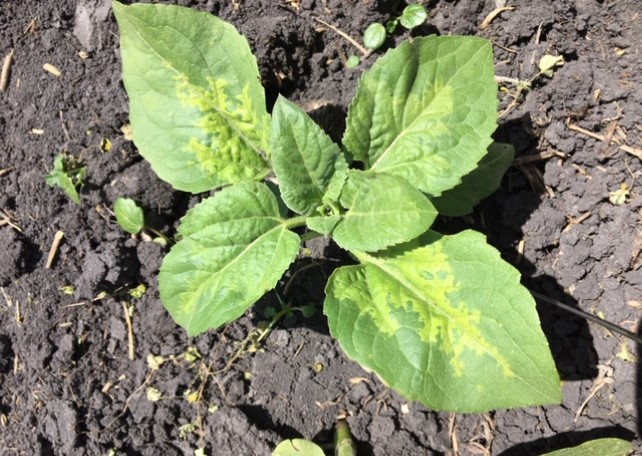Downy mildew is a common sunflower disease, capable of killing or stunting plants, reducing stands and causing yield loss.
Photos courtesy of Sam Markell, Extension Plant Pathologist, NDSU Department of Plant Pathology

Description: Plants with systemic downy mildew are recognized by the stunted plants, yellow symptoms on the main veins and downy white growth on the the lower surface of the main veins. Symptoms of secondary spread are small yellow spots on the leaves with a downy white growth on the lower leaf surface opposite the yellow areas.
Time of Attack: Can occur in sunflower when 2-3 inches of rain occur within two to three weeks of planting.
Damage: Severely infected plants may die before or shortly after emergence or in the seedling stage. If infected plants reach maturity they seldom produce viable seed. Heads on these plants typically face straight up, rendering them extremely vulnerable to bird feeding.
Downy Mildew Management
Sunflower growers can protect their yields by choosing hybrids with built in downy mildew resistance (DMR). Nuseed has several downy mildew resistant hybrids and in recent years launched two new DMR high oleic hybrids, N4H470 CL Plus and N4H521 CL, with the added protection of Plenaris® seed treatment.


Adding a seed treatment technology to the seed, such as Plenaris, helps stay one step ahead of diseases, like downy mildew, that have many races and can adapt to overcome protection practices.
For example, since 1980, downy mildew races have overcome some downy mildew resistance traits in sunflower hybrids and have become insensitive to chemistries used to control the disease. Although crop rotation is effective for other sunflower diseases such as sclerotinia, rust and phomopsis, rotation has minimal effect on downy mildew management because overwintering spores will survive in the soil up to ten years.


Downy mildew is a primary example of a disease that can overcome all the control mechanisms, whether it’s crop rotation, genetic resistance or seed treatments. It’s important to keep presenting new control tactics to keep it in check. Because this is an adaptive organism we need lots of tools. To manage it effectively, we continually need new resistance genes as well as novel fungicides.
Read more in Nuseed’s SUCCEED magazine articles about downy mildew and other diseases you can take action against.
The NDSU Disease Diagnostic Series is also a great resource for learning about sunflower diseases, what growers should look for and what can be done to reduce their affects of diseases.
